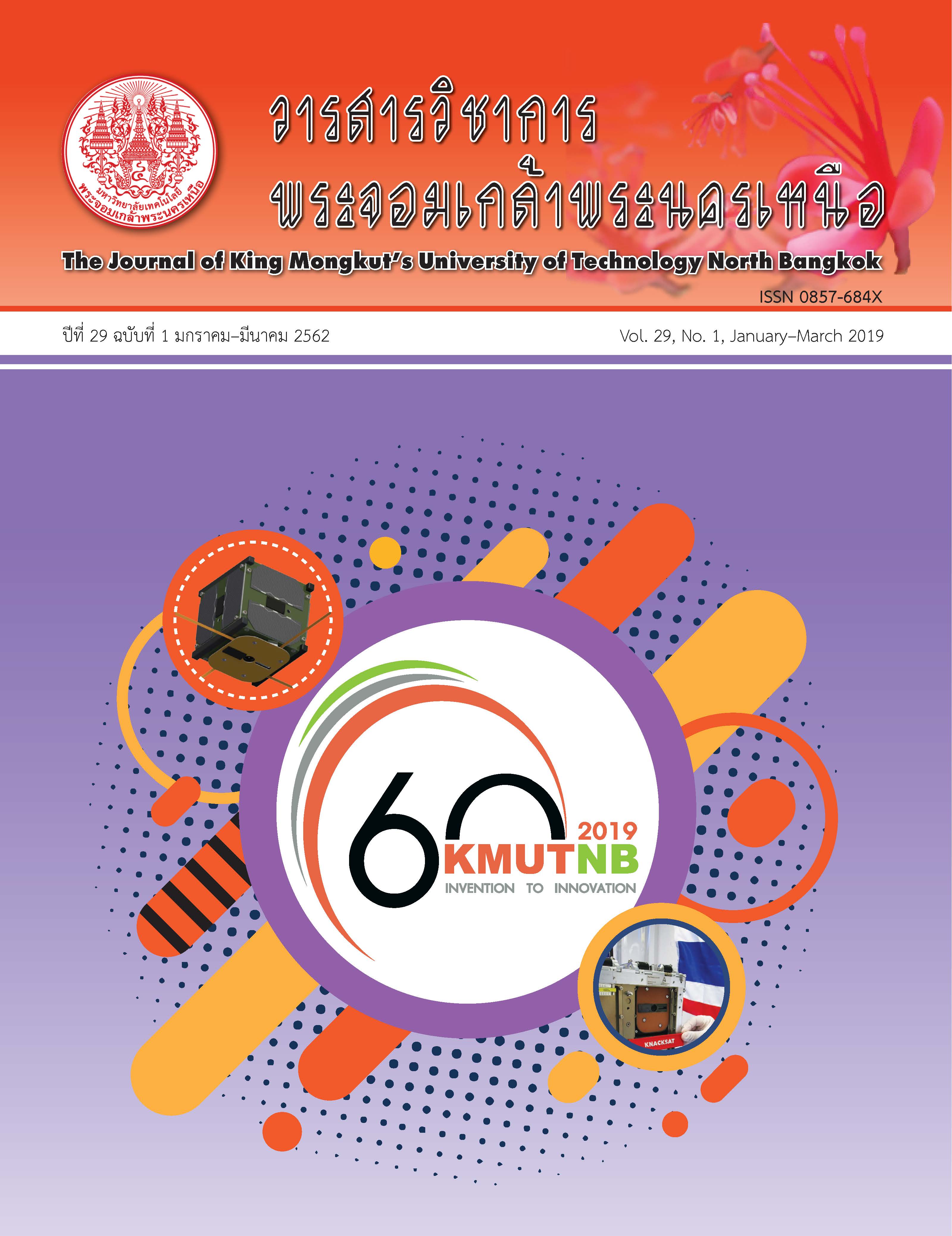ผ้าจีวรเคลือบด้วยนาโนคาร์บอนและไทเทเนียมไดออกไซด์ย้อมด้วยผงสีย้อมธรรมชาติ
Main Article Content
บทคัดย่อ
งานวิจัยนี้พัฒนาผ้าจีวรเคลือบด้วยนาโนคาร์บอนและไทเทเนียมไดออกไซด์ย้อมด้วยผงสีย้อมธรรมชาติ โดยศึกษาสมบัติทางกายภาพของผ้าฝ้าย ผ้าไหมและผ้ามัสลินที่เคลือบด้วยนาโนคาร์บอนและไทเทเนียมไดออกไซด์และศีกษาสมบัติการต้านเชื้อรา เชื้อแบคทีเรีย และการต้านรังสียูวี พบว่า ผ้าฝ้าย ผ้าไหมและผ้ามัสลินเคลือบด้วยนาโนคาร์บอนและไททาเนียมไดออกไซด์ สามารถยับยั้งเชื้อแบคทีเรียได้ทั้งชนิดแกรมบวก และแกรมลบ ความคงทนของสีต่อแสงของผ้าฝ้าย ผ้าไหมและผ้ามัสลินที่ไม่เคลือบและเคลือบด้วยนาโนคาร์บอนและไทเทเนียมไดออกไซด์ย้อมสีจากเปลือกหอมและเปลือกมะพูดเติมสารช่วยติดสีอัตราส่วนต่างๆ พบว่า มีค่าเฉลี่ยอยู่ในระดับ 3–4 (ปานกลาง-ดี) และความคงทนของสีต่อการซักล้างเฉลี่ยอยู่ในระดับ 4–5 (ดี–ดีมาก) ความสามารถในการป้องกันรังสี UVA และ UVB ของผ้าฝ้าย ผ้าไหมและผ้ามัสลินที่เคลือบด้วยนาโนคาร์บอนและไททาเนียมไดออกไซด์อัตราส่วน 0.01 : 0.49 มีค่า UPF ในการป้องกันรังสียูวีมากกว่า 50 คือ มีความสามารถในการป้องกันรังสีอัลตราไวโอเลตได้สูงสุด (มากกว่า 98 เปอร์เซ็นต์) และมีเปอร์เซ็นต์การส่องผ่านของรังสีอัลตราไวโอเลตบี ≤2.5
Article Details
บทความที่ลงตีพิมพ์เป็นข้อคิดเห็นของผู้เขียนเท่านั้น
ผู้เขียนจะต้องเป็นผู้รับผิดชอบต่อผลทางกฎหมายใดๆ ที่อาจเกิดขึ้นจากบทความนั้น
เอกสารอ้างอิง
[2] Trigiworn. (2017, May 17). Trigiworn. [Online]. Available: http://th.wikipedia.org/wiki/ไตรจีวร (in thai)
[3] What is the color of the robe?.(2018, Nov. 27). [Online]. Available: http://www.ch3thailand.com/news/scoop/13534 (in thai)
[4] A. Yadav, V. Prasad, and A. Kathe, “Functional finishing in cotton fabrics. using zinc oxides nanoparticles,” Bulletin of Materials Science, vol. 29, no. 6, pp. 614–645, 2006.
[5] K. Maabong, C. M. Muiva, P. Monowe, T. S. Sathiaraj, M. Hopkins, L. Nguyen, K. Malungwaand, and M. Thobega, “Natural pigments as photosensitizers for dye-sensitized solar cells with TiO2 thins films,” International Journal of Renewable Energy Research, vol. 5, no. 1, pp. 501–506, 2015.
[6] L. Karimi, S. Zohoori, and A. Amini, “Multiwall carbon nanotube and nano titanium dioxide coated on cotton fabric for superior self-cleaning and UV blocking,” New Carbon Material, vol. 29, no. 5, pp. 380–385, 2014.
[7] M. Z. B. Mukhlish, F. Najnin, M. M. Raman, and M. J. Uddin, “Photocatalytic degradation of different dyes using TiO2 with high surface area: A kinetics study,” Journal of Scientific Research, vol. 5, no. 2, pp. 301–314, 2013.
[8] Thai Encyclopedia for Youth. (2018, October). Nanomaterials. Thai Junior Encyclopedia Project By Royal Command Of H.M. The King. Bangkok. Thailand [Online]. Available: http://kanchanapisek.or.th/kp6/sub/book/book.php?book=32&chap=8&page=t32-8-infodetail04.html (in thai)
[9] L. Karimi, M. Mirjalili, and M. E. Yazdanshenas, “Effect of nano TiO2 on self-cleaning property of cross-link cotton fabrics with succinic acid under UV irradiation,” Photochemistry and Photobiology, vol. 86, no. 5, pp. 1030–1037, 2010.
[10] G. Goncalves, P. A. A. P. Marques, R. J. B. Pinto, T. Trindade, and C. P. Neto, “Surface modification of cellulosic fibres for multi-purpose TiO2 based nanocomposites,” Computer Science Technology, vol. 69, no. 7–8, pp. 1051–1056, 2009.
[11] Q. Li, S. L. Chen, and W. C. Jiang, “Durability of nano ZnO antibacterial cotton fabric to sweat,” Journal of polymer Science, vol. 103, pp. 412–416, 2007.
[12] S. Tangkawanit, M, Chantarangsee, B. Tangkanobon, and C.Supasorn, “Development of natural dyes powder for cotton and silk industrial in Ubon Ratchatani,” Ubon Ratchathani Rajabhat University, Thailand, Research Report, pp. 1–212, 2008 (in thai).
[13] R. M. Silverstein and F. X. Webster, Spectroscopic Identification of OrganicCompounds. John Wiley & Sons Inc., 1998, pp. 214.
[14] W. Hongguang, G. Xian, and H. Li, “Grafting of nano-TiO2 onto flax fibers and the enhancement of the mechanical properties of the flax fiber and flax fiber/epoxy composite,” Composites Part A: Applied Science and Manufacturing, vol. 76, pp. 172–180, 2015.
[15] G. Wang, “Enhanced photocatalytic activity of TiO2 Powders (P25) via calcination treatment,” International Journal of Photoenergy, vol. 2012, pp. 1–9, 2012.
[16] S. Wang, Q. Ma, H. Liu, K.Wang, L. Ling, and K. Zhang, “Robust electrospinning cellulose acetate@TiO2 ultrafine fibers for dyeing water treatment by photocatalytic reactions,” The Royal Society of Chemistry, vol. 5, no. 1, pp. 40521–40530, 2015.
[17] M. H. Haghi, B. J. Mohammad, S. Saman, M. Kazem, F. Farzad, and S. G. Marjan. “Antibacterial effect of TiO2 nanoparticle on pathogenic strain of E. coli.,” International Journal of Advanced Biotechnology and Research, vol. 3, pp. 621–624, 2012.
[18] F. Alimohammadi, M. P. Gashti, and A. Shamei, “A novel method for coating of carbon nanotube on cellulose fiber using 1,2,3,4-butanetetracarboxylic acid as a cross-linking agent,” Progress in Organic Coatings, vol. 7, no. 3, pp. 470–478, 2012.
[19] M. Abbasipour and M. K. Mehrizi, “Investigation to changes of reflective behavior of cotton/polyester fabric by TiO2 and carbon black nanoparticles,” Scientia Iranica, vol. 19, no. 3, pp. 954–957, 2012.
[20] D. Grifoni, L. Bacc, S. Di, L. Patrizia, Pi. Arianna, S. Francesca, C. Francesco, S. Gaetano, and Z. A. Romani. “UV protective properties of cotton and flax fabrics dyed with multifunctional plant extracts,” Dyes Pigments, vol. 105, pp. 89–96, 2014.

